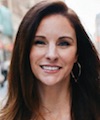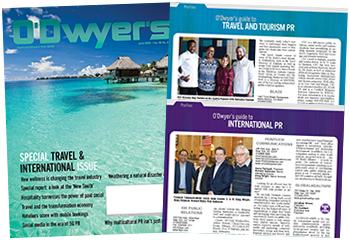 Amy Ogden |
Let’s be honest, social media can feel like a moving target. It seems like every week produces a new feature, tool or algorithm change. Something you’ve probably heard more and more about in the past year is paid social media, which might feel like just another “thing” to keep up with. However, paid social is a key part of any good social media campaign and understanding how it works will bring your social strategy to a new level and show true ROI.
Have you ever wondered if paid social media really works for booking hotel rooms? In an ROI-driven industry, that’s a valid question. Here’s a real-world example of paid social for a hotel (certain names and details have been changed to protect the brilliant):
The Islands had captivated honeymooners for decades — often at a price point they would not pay otherwise. Then, in 2016, Zika made its first appearance on the islands. Immediately, this started scaring off freshly married couples who were not willing to risk exposure.
|
|
One of the Island’s top destinations, Hotel X, saw a steep decline in bookings. Decades of marketing efforts were out the door. So, what now?
DINKs (double income, no kids), particularly those in the LGBTQ+ market, were the solution. Through social media, Hotel X was able to rebrand themselves through visuals and partnerships to appeal to this audience. From there, content was lifted to social media users who fit the target, living in the hotel’s direct flight markets. Within 6 months, spending $1,000 a month on paid social ads, the hotel saw $1,000,000 in confirmed bookings, tied to the paid social media campaign as a key conversion touchpoint.
That’s just one example of a smart, ROI-driven paid social campaign. Let’s go back a few years to understand how we got here and how we can work with today’s current social media space to show true ROI and leverage paid social media in the smartest way possible.
The numbers are staggering: 7.6 billion people in the world; 2.8 billion using social media; Facebook reported advertising revenue of $35.8 billion in 2017.
The good news: 10 years ago, 7 percent of the US population used one or more social networking sites. Today that figure is 65 percent. That’s great news; there are so many people to reach through your social channels.
The bad news: This means billions of people are logging in daily to see posts from billions of people and brands, causing a mind-bending digital traffic jam. To offset this information overload, Facebook has implemented algorithms to filter what content your followers see, essentially “choosing” what Facebook thinks a follower wants to see and hiding the rest. Even if someone follows your page or brand, they may never see your posts unless they proactively go to your page.
Reality check: In 2012, Facebook Business Pages were reaching 100 percent of their audiences organically (no payment required). Today, that number is about seven percent on the high end. This explains why you may see a page with 10,000 followers but nine likes on a post. Introducing social media ads. The obvious reason for ads is to support the currently free business model, but this also offers marketers a way to target their audience in a way like never before at a price unheard of at this scale.
Due to Facebook’s extensive algorithmic efforts to make the platform an interesting place for people to spend time online, they gather as much data on users as possible. This means your ads can be targeted towards active users who have provided every detail about their lives: job updates, marriages and breakups, brands they love, the music they listen to and even where they vacation.
The best news yet, these ads are relatively inexpensive compared to traditional advertising and they are trackable with the implementation of the Facebook Pixel. What is the Facebook Pixel? The Pixel is used for conversion tracking, optimization, and remarketing on Facebook and Instagram, allowing you to track the efforts tied to lifestyle content needed for success in 2018’s digital landscape. The Pixel allows you to customize your audience based on activity on your website. You can remarket to everyone who visits your site or define rules for people who visit specific pages or take specific actions. From there, you can track the actions that matter. The pixel automatically tracks visits across your website. You can add custom events to track actions like viewing specific content, entering the booking engine or making a purchase.
Ads Manager reporting tools allow you to see if your social media feeds are driving their intended goal. By spotting trends over time, you can identify areas to adjust — for instance, your image, budget or audience — to improve social media performance.
What this means in a nutshell:
For a relatively small budget you can create and implement ads that are more targeted than ever before with the added budget of direct attribution.
The implementation of the Pixel allows you to see exact details about your ads and also direct results: rooms booked, sites visited, actions taken.
Social media marketing has never been more quantifiable.
Where do you go from here? If you’re starting from a classic organic paid strategy (posting images with no paid strategy), here’s a good roadmap:
Create gorgeous content. Either hire a social media photography team or take a few classes and shoot your property yourself. It all starts with beautiful, socially-driven content.
Implement a smart paid campaign. You can do this yourself by learning how it works and keeping up with changes in the industry or you can partner with a paid social team to manage this for you.
Continue to build your following. You can do this through consistent strategies including engaging with new guests who are visiting the property, following fans of synergistic properties and engaging with current and past brand fans.
This is such an exciting time in branding, marketing and sales teams. Never before have we been able to target and track so specifically. Embrace this new opportunity, learn how to navigate it or find a great partner and get ready to bring your brand and sales to a new level.
***
Amy Ogden is senior vice president of brand development at JPR.



 Weber Shandwick is providing PR and marketing communications services to the Moroccan National Tourist Office in New York.
Weber Shandwick is providing PR and marketing communications services to the Moroccan National Tourist Office in New York. Finn Partners has filed its six-month contract with the Bahamas Ministry of Tourism, Investments & Aviation, which is worth $240K.
Finn Partners has filed its six-month contract with the Bahamas Ministry of Tourism, Investments & Aviation, which is worth $240K. Weber Shandwick wrapped up its work for the Ministry of Bahamas at the end of 2023.
Weber Shandwick wrapped up its work for the Ministry of Bahamas at the end of 2023. The Aruba Tourism Authority is boosting its budget 29.4 percent to $2.2M at Zeno Group, according to its 2024 contract, effective Jan. 1.
The Aruba Tourism Authority is boosting its budget 29.4 percent to $2.2M at Zeno Group, according to its 2024 contract, effective Jan. 1. As inflation continues to impact spending, consumers are revisiting their list of what they’re willing to spend more of their money on. Luckily for those in the travel industry, experiences seem to be trending up on the “splurge” list.
As inflation continues to impact spending, consumers are revisiting their list of what they’re willing to spend more of their money on. Luckily for those in the travel industry, experiences seem to be trending up on the “splurge” list. 


 Have a comment? Send it to
Have a comment? Send it to 
No comments have been submitted for this story yet.